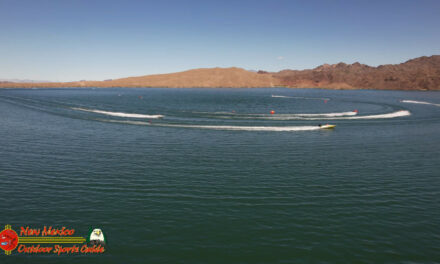Many anglers have fished for years, not understanding the physical and mental make-up of a bass’s system. To increase productivity in anything, one must first do some homework on what makes anything “tick”. And, that includes the bass. A bass’s senses include sight, hearing, smell, taste, and feel, however they are different than human’s senses because their brain is more primitive. Because of this, their senses must react to their environment differently. Humans can think and reason, animals react. Their lives are governed through genetics, and their existence is programmed through their senses. The physical and mental make-up of a bass is simple, but yet sophisticated compared to other animals.
A bass’s eyesight is excellent, and is absolutely the most important sense it has. Without eyesight, a bass would have a short life span. It is the dominant force used for seeking and selecting food. A fish’s retina is made up of cones for color vision and rods for black, white, and shades of gray vision. A bass’s eyes can receive up to 5 times more light than a human, and this allows them to distinguish shapes, sizes, movement, and color patterns that the human eye can’t, even under varying water clarity and light conditions. They do not have lids, but are able to change the shape of the eyeball to varying conditions of light. They have wide field vision, a full 180 degrees for each eye. Bass’s eyes improves with age, and will continue to grow throughout it’s life. Bass can see color, extensive experiments have been done on color and bass perception. Yellow and blue are both less distinct than other colors. Bass see red and violet best, and green second best, but they can discriminate between all colors.
Hearing – The lateral line is a hearing organ designed for sounds close to the fish. It extends from behind the gills to the tail on either side of the fish. It is as accurate as a radar in pin pointing the presence of an object. Anything moving through the water must displace water molecules. It is this displacement that is picked up by the lateral line, and the fish can strike the source of that sound as effectively as if it were seen with the eyes. The lateral line works only with near field sounds, those that are within a few feet of the bass, but is a deadly system
Hearing – The ear system is inside their heads, although they do not have external earflaps as we do. Their bodies act as a sounding board, and they can hear and react to sounds a long distance away. This organ is real sensitive, and through their ears is what makes bass spook away sometimes.
Bass’s sense of smell is keen, but sense of smell and taste does not really affect their behavior. Sense of smell is called olfaction. Sharks, catfish, and salmon has been studied in depth, and are known to have a greater sense organ, and use it more fully in their lives. Bass use their smell for foraging and protection. Bass preyfish are made of amino acids, building blocks of protein. And. can smell small frightened preyfish up to 25 feet away. They use it to find their way back to certain feeding and spawning areas. Their migrating abilities allows them to return home through their olfactory perception. Smell is used in reproduction, territorial claims, and communicating with each other. Located on each side of the head. Chemoreception is the most primitive sense in the universe, and it is used to avoid harmful PH conditions, flee from harmful chemicals, to find food, and find suitable dissolved oxygen content. It forms the basis of the bass’ entire behavior.
Scents – potions for adding to the lure, are the rage. They generate 40 – 50 million dollars in sales. They are slow to permeate the water, and are quickly carried off by the water. Scents may make the lure more positive, mask human smell, and make the bass hold the bait longer. You can overpower the olfactory system by saturating the water with scent. Someone who strongly reeks with perfume tends to repel people! Naturally, the manufacturers want you to use it a lot, so they tell you to soak it. Possibly, the optimal time to use scent is in cold water, where water doesn’t displace as quickly. Manufacturers claim their products work on inactive bass, but obviously active bass will hit anything! On the other hand, WD 40 has been used, anise oil, fruit flavored vaseline, and all sorts of home remedies have been claimed to work. You be the judge, of course if you catch a fish, using anything, you then have confidence in the item. But, whose to say that bass wouldn’t have hit your bait, had you not had the scent on?
Taste works the same way. A bass has already sized up whether he wants your lure or not. So you must appeal to his other senses. Sight first, hearing, so he can hone in on your bait, smell and taste so he will hold on to it longer.
As one can see, a bass’s senses is important for the bass to live out a full life. But, it is equally important that an angler understand a bass’s senses to aid in their pursuit of this beautiful creature – the LARGEMOUTH BASS.
Editors Note: Sherry Ruslink is sponsored by Triton Boats/Mariner Motors, Four Seasons Marine, Lowrance, Castaway Graphite Rods – Factory Team, Gene Larew Lures, McCoy’s Mean Green Fishing Line, Pro Line, Motorguide, Top Brass Tackle, and Lockhart Lures.. She is a licensed guide on Lake Fork, Touring Pro, member of Texas Outdoor Writers Assoc., instructor and seminar speaker on bass fishing, TPWD angler educator, and owner of Anglers Educational Seminars. You can reach her at 1-877-523-9227, email: ladybass@koyote.com, URL: http://www.texs.com/ladybass/fork.htm
—
Sherry D. Ruslink email: ladybass@koyote.com
Rt 1, Box 190-D-8 http://www.texs.com/ladybass
Emory, TX 75440 http://www.texs.com/ladybass/fork.htm
903-473-1016 http://www.texs.com
1-877-523-9227 http://www.texs.com/lvl
Anglers Educational Seminars http://www.wmi.org/Bassfish
Prof Tournament Angler http://www.tbbu.com/magazine/index.htm
Outdoor Writer ICQ – 2138299
– Lake Havasu
– Lake Havasu












